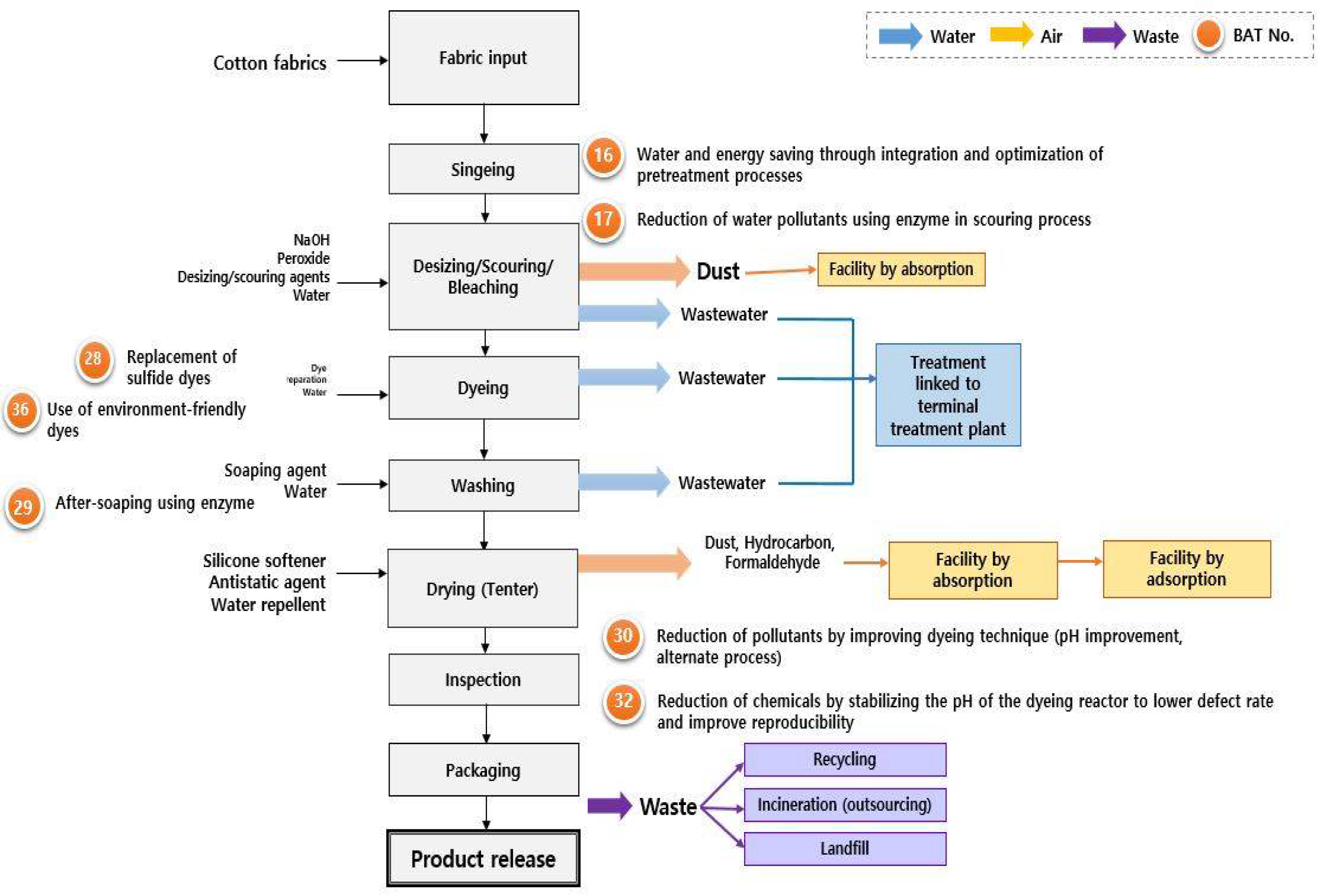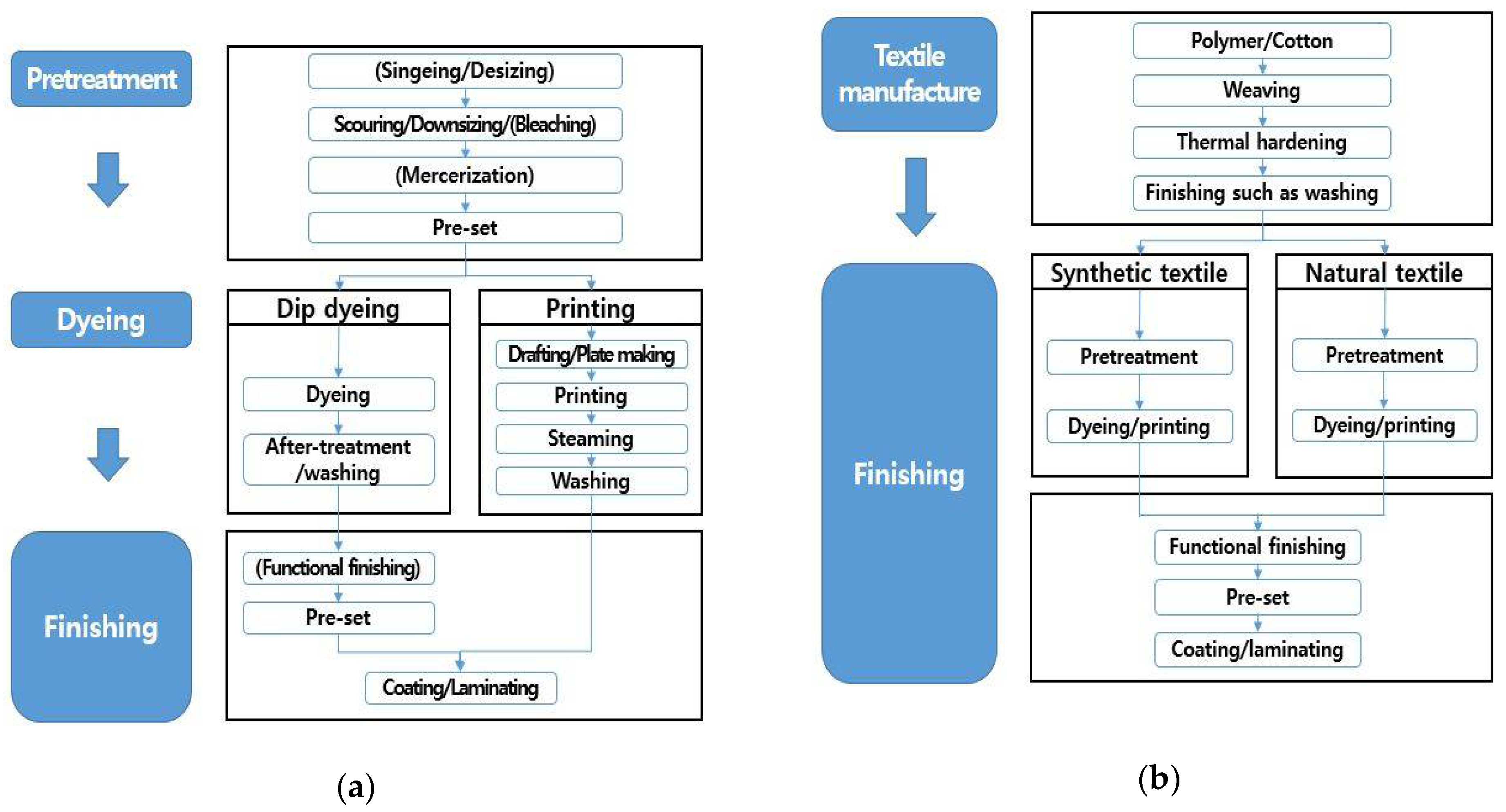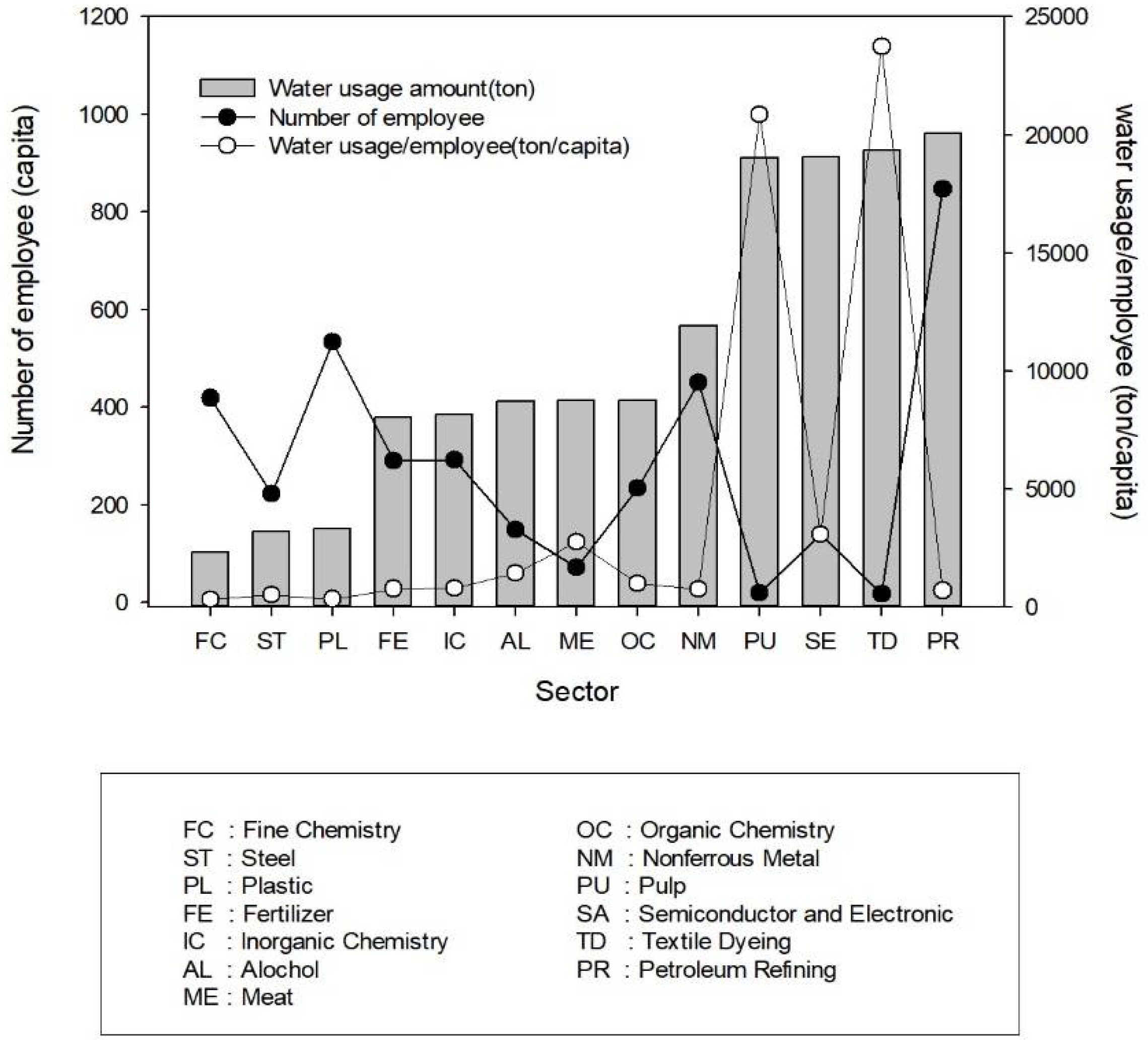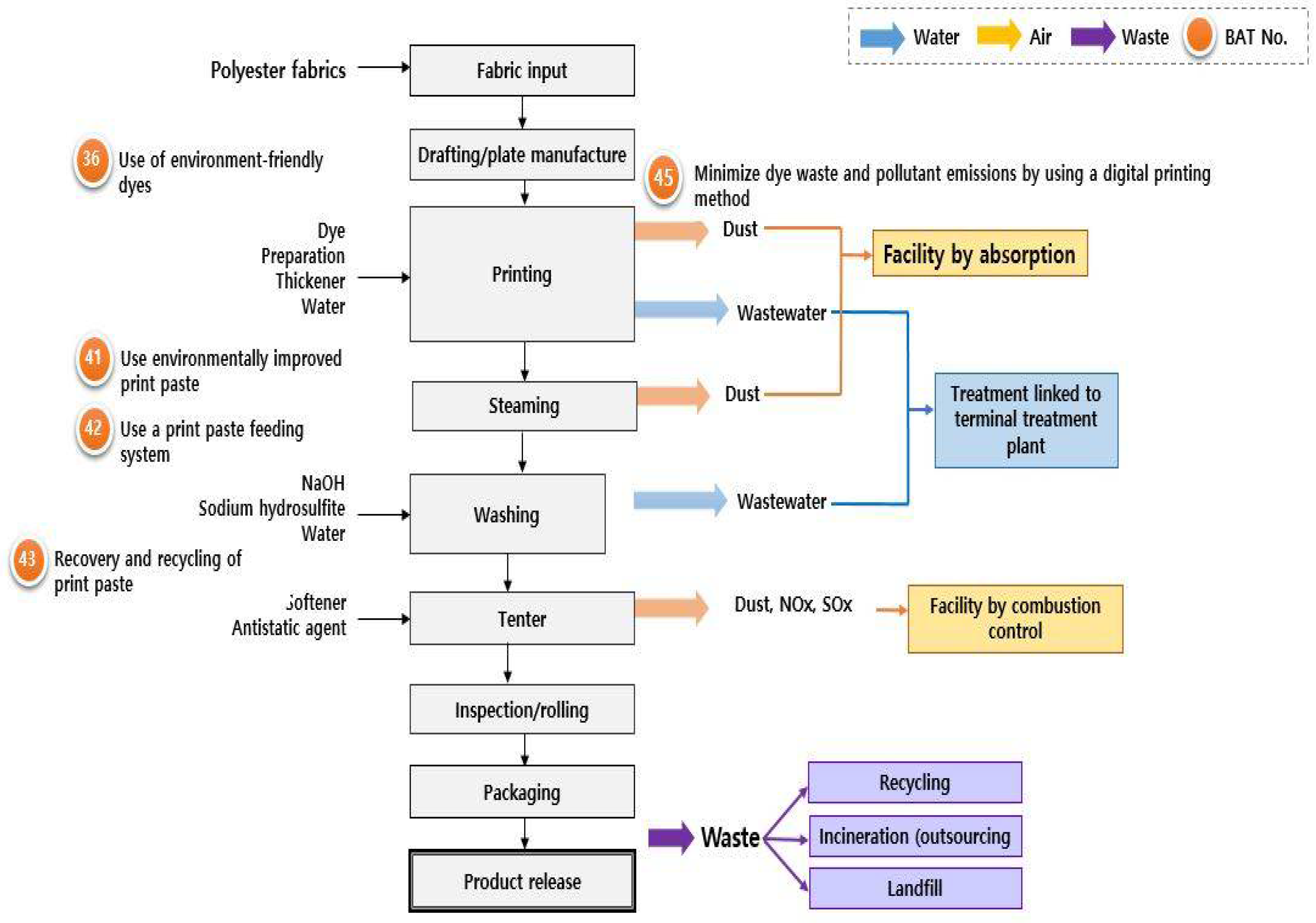Application of Best Available Techniques to Remove Air and Water Pollutants from Textile Dyeing and Finishing in South Korea
Abstract
1. Introduction
2. Materials and Methods
2.1. Processes of the Textile Dyeing and Finishing Industry
2.2. Environmental Problems in the Textile Dyeing and Finishing Industry
2.3. BATs and BAT-AELs of the Textile Dyeing and Finishing Industry
3. Results and Discussion
3.1. BATs

3.2. Comparison with EU-BREF
3.3. BAT-AEL
3.4. Limitations and Further Studies
3.4.1. BATs
3.4.2. BAT-AELs
Author Contributions
Funding
Acknowledgments
Conflicts of Interest
References
- Integrated Pollution Prevention and Control (IPPC). Laying down Rules Concerning Guidance on the Collection of Data and on the Drawing up of BAT Reference Documents and on Their Quality Assurance Referred to in Directive 2010/75/EU of the European Parliament and of the Council on Industrial Emissions, EU. 2012. Available online: https://eur-lex.europa.eu/eli/dec_impl/2012/119/oj (accessed on 24 November 2010).
- Seo, K.A.; Kim, G.H.; Kim, E.S.; Seok, H.J.; Shin, S.J.; Kim, Y.L.; Kang, P.G. Comparative Analysis of Best Available Techniques Reference Documents on the Fertilizer Manufacture Between Korea and European Union. J. Environ. Sci. Int. 2020, 29, 307–318. [Google Scholar] [CrossRef]
- Ministry of the Environment (MOE). Act on Clean Air Conservation Act. 2021. Available online: https://law.go.kr/lsSc.do?section=&menuId=1&subMenuId=15&tabMenuId=81&eventGubun=060101&query=%EC%88%98%EC%A7%88%ED%99%98%EA%B2%BD#undefined (accessed on 30 December 2021).
- Ministry of the Environment (MOE). Act on Water Environment Conservation Act. 2022. Available online: https://law.go.kr/lsSc.do?section=&menuId=1&subMenuId=15&tabMenuId=81&eventGubun=060101&query=%EC%88%98%EC%A7%88%ED%99%98%EA%B2%BD#undefined (accessed on 13 January 2022).
- Ministry of the Environment (MOE). Act on Integrated Management of Environmental Pollution Facilities. 2021. Available online: https://law.go.kr/lsSc.do?section=&menuld=1&subMenuId=15&tabMenuId=81&eventGubun=060101&query=%ED%86%B5%ED%95%A9%ED%99%98%EA%B2%BD%EA%B4%80%EB%A6%AC%EB%B2%95#undefined (accessed on 21 July 2021).
- Shin, S.; Park, J.; Park, S.; Lee, D.; Kim, D. Understanding and Improvement of Best Available Techniques for Waste Incineration Facility. J. Korean Soc. Atmos. Environ. 2017, 33, 533–543. [Google Scholar] [CrossRef]
- Kim, H.K. The Appraisal and the Tasks of the Act on Integrated Pollution Prevention and Control. J. Kor. Sox. Environ. Law 2016, 38, 327–361. [Google Scholar]
- Kim, G.H.; Kim, E.S.; Seo, K.A.; Kang, K.H.; Khan, J.B.; Seok, H.J.; Kang, P.G. Application of Best Available Techniques Reference Document for the Paint Manufacturing Industry. Korean J. Hazard. Mater. 2019, 7, 36–41. [Google Scholar]
- Kim, E.S.; Kim, G.H.; Seo, K.A.; Khan, J.B.; Seok, H.J.; Kim, Y.L.; Kang, P.G. Introduction on Best Available Techniques Reference Document for the Display Manufacturing Industry in Korea. Korean J. Hazard. Mater. 2019, 7, 42–49. [Google Scholar] [CrossRef]
- National Institute of Environmental Research (NIER) SOP. Operation Rules for the Preparation of Best Available Techniques Reference Documents. 2020. Available online: https://www.nier.go.kr/NIER/cop/bbs/selectNoginBoardArticle.do?menuNo=13001&bbsld=BBSMSTR_000000000031&nttld=27117&Command=READ/?pMENUMST_ID=95 (accessed on 6 January 2020).
- Sana, K.; Abdul, M. Environmental and Health Effects of Textile Industry Wastewater, Environmental Deterioration and Human Health; Springer: Berlin/Heidelberg, Germany, 2014; pp. 55–71. [Google Scholar]
- Kim, T.W.; Seo, B.J.; Park, G.H.; Lee, Y.W. Predicting Diffusion Behavior of Disperse Dyes in Polyester Fibers by a Method Based on Extraction. 2020. J. Supercritical. Fluids. 2020, 157, 104685. [Google Scholar] [CrossRef]
- Ministry of SMEs and Startups. Framework Act on Small and Medium Enterprises. 2021. Available online: https://law.go.kr/lsSc.do?section=&menuId=1&subMenuId=15&tabMenuId=81&eveGubun=060101&query=%ED%86%B5%ED%95%A9%EA%B4%80%EB%A6%AC#undefined (accessed on 30 December 2021).
- National Institute of Environmental Research (NIER). Reference Document on Best Available Techniques in the Textile Dyeing Industry. 2019. Available online: https://ieps.nier.go.kr/web/board/5/666/?pMENUMST_ID=95 (accessed on 6 January 2020).
- Integrated Pollution Prevention and Control (IPPC). Integrated Pollution Prevention and Control Reference Document on Best Available Techniques for the Textiles Industries, EU. 2003. Available online: eippcb.jrc.ec.europa.eu/sites/default/files/2019-11/txt_bref_0703.pdf (accessed on 6 July 2003).
- National Institute of Environmental Research (NIER). Water Emission Management System. 2018–2019. Available online: htpps://wems.nier.go.kr/board/viewMpReferenceList.do (accessed on 9 September 2020).
- Dos Santos, R.F.; Ramlow, H.; Dolzan, N.; Machado, R.A.F.; de Aguiar, C.R.L.; Marangoni, C. Influence of Different Textile Fibers on Characterization of Dyeing Wastewater and Final Effluent. Environ. Monit. Assess. 2018, 190, 693. [Google Scholar] [CrossRef] [PubMed]
- Wang, Z.; Xue, M.; Huang, K.; Liu, Z. Textile Dyeing Wastewater Treatment. In Advances in Treating Textile Effluent; Hauser, P., Ed.; Intech Open Sci: London, UK, 2011; pp. 91–116. [Google Scholar]
- National Institute of Environmental Research (NIER). Guidebook for Licensing and Permission of Wastewater Discharge Facilities. 2017. Available online: me.go.kr/home/web/policy_data/read.do?pagerOffset=0&maxPageltems=10&maxlndexPages=10&searchKey=&searchValue=&menuld=10259&orgCd=&condition.deleteYn=N&seq=7396 (accessed on 24 October 2019).
- Hong, S.I.; Nam, C.W.; Lee, W.S. Analysis of the Dye Absorption Behavior in Accordance with the Dye Structure in the Cold Pad Batch Dyeing of Cotton Knit. Text. Color. Finish. 2016, 28, 175–182. [Google Scholar] [CrossRef][Green Version]
- Seo, K.A.; Bae, Y.J.; Park, J.H.; Shin, D.S.; Rhew, D.H. Determination of Best Available Techniques Associated Emission Level (BAT-AEL). J. Environ. Sci. Int. 2019, 28, 455–464. [Google Scholar] [CrossRef]



| Classification | Content |
|---|---|
| Materials | Cotton and cellulose Polyester Nylon Wool Silk, etc. |
| Processes | Pre-treatment (singeing, desizing, scouring, mercerizing, bleaching, etc.) Dyeing/Printing Post-treatment (dehydration, drying, coating, finishing) |
| Fibrous assembly types | Raw materials Yarns Weaving Knitting |
| Classification | Pollutants | |
|---|---|---|
| Water pollutants discharge list (32 types) | Specific substances harmful to water quality (14 types) | Copper and copper compounds, lead and lead compounds, mercury and mercury compounds, cyanide compounds, hexavalent chrome compounds, cadmium and calcium compounds, dichloromethane, chloroform, 1,4-dioxane, diethyl hexyl phthalate (DEHP), acrylonitrile, naphthalene, formaldehyde, and epichlorohydrin |
| Water pollutants (18 types, excluding specific substances) | Organic matter (biochemical oxygen demand (BOD) and chemical oxygen demand (COD)), suspended solids (SS), total nitrogen (T-N), total phosphorus (T-P), oils (mineral oil), oils (animal and vegetable oils), nickel and nickel compounds, manganese and manganese compounds, barium compounds, fluorine compounds, detergents, zinc and zinc compounds, iron and iron compounds, chrome and chrome compounds, perchlorate, phenols, and acids and alkalis (pH) | |
| Process | Raw Materials | Process Description | Major Environmental Problems |
|---|---|---|---|
| Desizing | Weak acid, oxidative acid, water, alkali (Na2CO3) | A process of adding a chemical (thickener) to impart strength | Air → Volatile organic compounds (VOCs) Water → High BOD load, discharges many non-biodegradable matters, high concentration of solids |
| Scouring | Alkali (NaOH), surfactant, water | A process of removing impurities for uniform dyeing | Water → High pH, BOD, and COD; high alkalinity; and toxic substances |
| Bleaching | Bleach (e.g., H2O2), water | A process of removing coloring matters after scouring | Water → Bleach residues, high pH, SS, and BOD |
| Mercerizing | Alkali (NaOH) | A process of improving the gloss and strength of textiles | Water → Strong alkalinity |
| Dyeing | NaOH, dye, surfactant, water, additives (e.g., oxidant) | A process of coloring textiles using chemicals | Air → VOCs, energy Water → High COD and BOD, odor, alternative oxidase (AOX), heavy metals, additives, discharge of undyed dyes |
| Printing | Pigment, dye, additives (e.g., oxidant) | A process of applying specific patterns or designs to textiles | Air → VOCs, methanol, formaldehyde, etc. Water → SS, AOX, COD is higher than BOD |
| Finishing | Heat, resin, softener | A process of imparting desired properties to textiles | Air → dust, sulfur oxides, formaldehyde, energy, etc. Water → SS, energy |
| Classification | BAT No * | Description |
|---|---|---|
| Dip dyeing | 16 | A technique to save water and energy consumption by integrating and optimizing individual pre-treatment processes applied to cotton materials. a. Application of integrated pre-treatment process for cotton textiles b. Optimization of cotton warp pre-treatment |
| 32 | A technique to decrease the defect rate by stabilizing the pH of the bath in which dyeing reaction occurs and to reduce the use of chemicals by improving reproducibility | |
| Printing | 43 | A technique to reduce pollutant discharge through the recovery and recycling of print paste a. Recovery of print paste from the supply system of a rotary screen printing machine b. Recycling of residual print pastes |
| 45 | A technique to minimize the waste of dyes and the discharge of pollutants using a digital printing method a. Use of a digital jet printing method for bulky textiles b. Use of inkjet digital printing method for flat textiles |
| Classification | Number of BATs | |
|---|---|---|
| In Manufacturing Facilities | In Prevention Facilities | |
| BATs in textile manufacturing BREF, Korea | 42 (84%) | 8 (12%) |
| BATs in BREFs, Korea | 590 (48%) | 651 (52%) |
| Classification | K-BREF | EU-BREF |
|---|---|---|
| BATs | 50 BATs in total | 113 BATs in total |
|
| |
| Characteristics | BATs about the reduction in general pollutant discharges from business sites as well as about water quality | Separate BATs about the carpet industry and about the treatment of effluent and wastes (sludge) |
|
|
| Main Category | Middle Category | Small Category | Detailed Category |
|---|---|---|---|
| Textile dyeing and finishing industry | Process facilities | Pre-treatment facilities | |
| Dyeing facilities | |||
| Finishing facilities | |||
| Common facilities | Solid particle storage facilities | ||
| Incineration facilities | Waste gas Incineration facilities | 200 kg∙h−1 | |
| Less than 2 t∙h−1 | |||
| Wastewater/waste incineration facilities | 200 kg∙h−1 | ||
| Less than 2 t∙h−1 |
| Classification | BAT-AELs for Air Pollutants | |||
|---|---|---|---|---|
| Pollutants | Unit | BAT-AEL | ||
| Pretreatment | Dust | 4–24 | ||
| HCl | ppm | 1–4 | ||
| Cadmium | 0–0.1 | |||
| Dyeing/finishing | HCl | ppm | 1–2 | |
| Phenol | ppm | 0–2 | ||
| Hydrocarbon | ppm | 7–34 | ||
| Incineration facilities | Waste gas incineration | Sulfur oxides | 4–27 | |
| Carbon monoxide | ppm | 21–154 | ||
| HCl | ppm | 2–13 | ||
| Wastewater/waste incineration | Sulfur oxides | 5–27 | ||
| Classification | BAT-AELs for Water Pollutants | ||
|---|---|---|---|
| Pollutants | Unit | BAT-AEL | |
| ≥2000 t/day—clean area | COD | mg∙L−1 | 18–30 |
| ≥2000 t/day—clean area | SS | mg∙L−1 | 2–17 |
| Clean area | T-N | mg∙L−1 | 12–30 |
Publisher’s Note: MDPI stays neutral with regard to jurisdictional claims in published maps and institutional affiliations. |
© 2022 by the authors. Licensee MDPI, Basel, Switzerland. This article is an open access article distributed under the terms and conditions of the Creative Commons Attribution (CC BY) license (https://creativecommons.org/licenses/by/4.0/).
Share and Cite
Kim, G.; Kang, P.-G.; Kim, E.; Seo, K. Application of Best Available Techniques to Remove Air and Water Pollutants from Textile Dyeing and Finishing in South Korea. Sustainability 2022, 14, 2209. https://doi.org/10.3390/su14042209
Kim G, Kang P-G, Kim E, Seo K. Application of Best Available Techniques to Remove Air and Water Pollutants from Textile Dyeing and Finishing in South Korea. Sustainability. 2022; 14(4):2209. https://doi.org/10.3390/su14042209
Chicago/Turabian StyleKim, Gahee, Phil-Goo Kang, Eunseok Kim, and Kyungae Seo. 2022. "Application of Best Available Techniques to Remove Air and Water Pollutants from Textile Dyeing and Finishing in South Korea" Sustainability 14, no. 4: 2209. https://doi.org/10.3390/su14042209
APA StyleKim, G., Kang, P.-G., Kim, E., & Seo, K. (2022). Application of Best Available Techniques to Remove Air and Water Pollutants from Textile Dyeing and Finishing in South Korea. Sustainability, 14(4), 2209. https://doi.org/10.3390/su14042209






